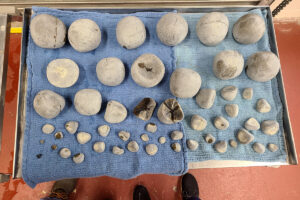Predicting and Preparing for Foaling

The leadup to foaling is an exciting time but also one of uncertainty. When will your mare foal? How can you ensure a safe delivery? What steps do you need to take?
To clear up some of the confusion and help breeders pinpoint and prepare for parturition (foaling), two assistant professors and AgriLife Extension horse specialists from Texas A&M University—Chelsie Huseman, PhD, and Jennifer Zoller, PhD—shared advice during a webinar hosted by the American Youth Horse Council. Here’s what they discussed.
When Will the Foal Arrive?
One of the first things breeders must do to prepare for foaling is calculate the mare’s expected delivery date, which you can do with basic math or the help on an online gestation calculator.
The mare’s average gestation length is approximately 335 to 345 days, said Zoller. So once you know your mare’s last breeding date, you can simply look about 335 days into the future to estimate her due date. Several factors, however, can affect how early or late a mare foals, said Zoller, including:
- Genetics If the mare’s dam had long gestation lengths, so could she.
- History If the mare had a long gestation length during her last pregnancy, expect the same this time around, she said.
- Status Your mare’s gestation period might be longer if she’s a maiden (never foaled before).
- Breeding date Mares bred earlier in the spring tend to have slightly longer gestations, said Zoller.
Keep these things in mind to avoid surprises.
Physical Changes To Watch For
A mare’s body undergoes predictable changes as she gets close to parturition. Evaluate her regularly in the three to four weeks before her expected due date to pick up on these and identify imminent foaling, said Zoller. Physical changes you might notice include:
- A dropped abdomen. The mare’s belly will become distended as her ligaments relax in preparation for foaling.
- Mammary gland and teat development. The udder will start to distend, the teats will fill out, and you might notice dripping milk. “Closer to foaling, the milk will be thicker and yellow in color as it gets closer to developing into colostrum,” said Zoller, referring to the antibody-rich milk foals must consume within the first 24 hours of life.
- Foaling is usually 12 hours away if the teats become waxy and develop balls of colostrum.
- Pelvic and vulvar changes. The ligaments around the mare’s pelvis will relax as the body prepares for foaling. “The body will feel spongey when you push on those hind muscles,” Zoller said, reminding owners to stand in a safe position out of kicking range when feeling this area. The mare’s vulva just under her tail will relax, as well, becoming swollen and elongated. These are additional signs that foaling is about 12 hours out.
- Abdominal symmetry. When viewed from the behind about four weeks before foaling, the mare’s abdomen will appear asymmetric. Closer to parturition, it will be much more symmetric as the foals gets into position in the birth canal, Zoller said.
Mares will also display changes in behavior close to foaling. “She might display signs of discomfort, pacing, looking at her abdomen,” said Zoller. “In the pasture she might find a spot off to herself instead of with other horses.”

Changes in Milk Composition
The calcium and pH levels in a mare’s milk change nearing foaling. You can collect and test samples of her milk regularly, starting three weeks before her delivery date (which is when the mammary glands begin to develop), to monitor for changes, said Zoller. Several easy-to-use commercial kits are available for this purpose.
To collect a milk sample by hand, Huseman advised starting at the mare’s shoulder while she’s restrained by a handler or stocks and working your way down the flank to her udder. Wash the udder with warm water and a mild soap such as Ivory. Then, she said, start at the top of one of the two mammary glands on each side of the udder, and apply firm pressure all the way down it—like squeezing a toothpaste tube—to release the milk into a clean container such as a plastic Pyrex with a handle.
Huseman said another milking option is to take a 60-milliliter plastic syringe, cut the top off, take the plunger out, and turn it around so it becomes an apparatus for drawing milk out. “Place the teat snugly inside it, get a nice seal, and draw the milk out,” she said.
You can find a variety of commercial devices that function the same way, as well as pumps with collection containers. “You can go real simple or real fancy with the tools available commercially,” said Huseman.
You can also use these techniques and devices when testing milk for colostrum quality post-foaling or collecting milk for the foal that can’t or won’t suckle.
Monitoring Your Mare
When your mare’s physical, behavioral, and milk changes all point to impending parturition, make sure your mare’s in a safe place for foaling and is under some sort of continual surveillance. Ideally, said Zoller, you want to move your mare to the environment where she’ll foal two to four weeks beforehand.
“That’s important for her comfort level and so she can develop antibodies to that environment to pass on to the foal,” she explained.
If stalled, make sure the mare has enough room to lie down and foal. Your typical 12-by-12-foot stall is too small; choose a 14-by-14-foot stall, or remove the partition between two smaller stalls to create a single large one, said Zoller. If pastured, make sure the mare has a clean, grassy area in which to foal.
Monitor the mare around the clock using manpower or a mechanical aid such as a phone app, smart halter device, or alarm sutured into the vulva, each of which sends you an alert to indicate foaling.
“Do research to see what device fits your program economically and benefits your situation,” said Zoller. “Just make sure you’re monitoring on a regular basis, because most mares foal at night when they feel most relaxed and protected.”
When foaling is indeed imminent, consider wrapping your mare’s tail so it stays out of the way, cleaning her vulva and teats, and contacting your veterinarian so he or she knows your mare is foaling and can arrive quickly if issues arise.

Related Articles
Stay on top of the most recent Horse Health news with

















